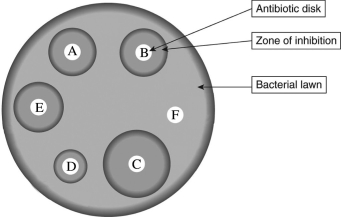Scenario
In order to test the susceptibility of bacteria (if the bacteria are susceptible to being killed) to an antibiotic, a common laboratory test called the Bauer-Kirby Disk Diffusion test is used. First, a petri dish (a shallow, circular, transparent dish with a flat lid) is partially filled with nutrient-enriched agar (a gelatinous material) . The nutrients encourage growth of specific bacterial species. The agar is poured as liquid but then typically solidifies to a soft consistency. Once the agar is set, a "lawn" of bacteria is spread such that a thin layer covers the top of the agar. Antibiotics are then applied to the lawn in a small dose, often through small, saturated paper disks. The dish is typically incubated for 24-48 hours and then observed for susceptibility. If the antibiotic is effective, it will kill the bacteria and leave a clear area called the "zone of inhibition" due to inhibited bacterial growth. The area starts at the source of the antibiotic and radiates outward. Scientists measure the diameter of the zone and then compare it to an established "cutoff value" for a zone specific to antibiotic/organism combinations. A large zone of inhibition in comparison to the standard indicates susceptibility while a small or no zone indicates resistance. Consider the following image, and answer the questions that follow: 
-After 1 year of widely prescribed use, reports surface that bacterial infections disappear for up to 2 weeks after taking the FDA-approved antibiotic but then reappear, sometimes worse than the first time. Which explanation might the FDA use to defend their choice of antibiotic to treat the infection?
A) Patients are not taking the antibiotic for the length of time prescribed, and so selection for resistant bacteria that can survive a limited course of the antibiotic is occurring.
B) Stabilizing selection over the year has allowed for the bacteria to remain at a high level in patients' bodies.
C) Patients' bodies are evolving over the year to create environments that are friendly to the growth of the bacteria.
D) Sexual dimorphism allowed for larger bacteria cells to outcompete smaller ones, therefore enabling larger bacteria cells to continue to multiply.
Correct Answer:
Verified
Q41: Scenario
Over the past 60 years, many amphibian
Q42: Scenario
In order to test the susceptibility of
Q43: Examine the relationships between the elephants in
Q44: Scenario
Over the past 60 years, many amphibian
Q45: Scenario
Drs. Peter and Rosemary Grant have been
Q47: The accompanying figure shows the percent of
Q48: Examine the evolutionary tree below. This tree
Q49: The accompanying figure shows what happens in
Q50: Scenario
In order to test the susceptibility of
Q51: Scenario
Drs. Peter and Rosemary Grant have been
Unlock this Answer For Free Now!
View this answer and more for free by performing one of the following actions

Scan the QR code to install the App and get 2 free unlocks

Unlock quizzes for free by uploading documents